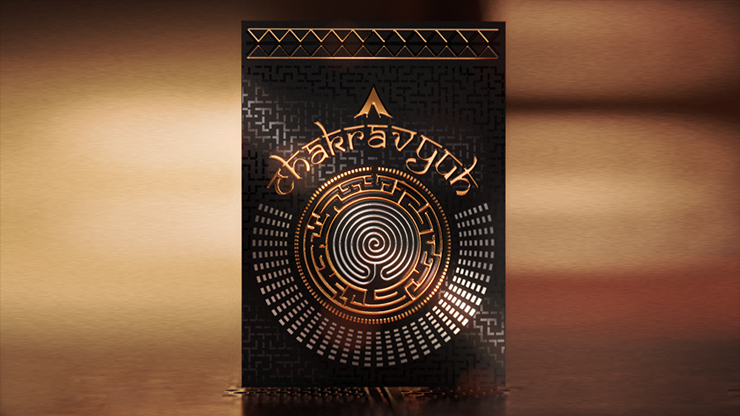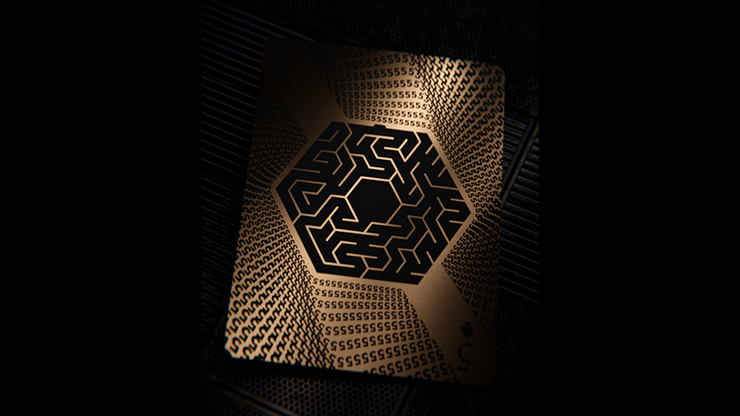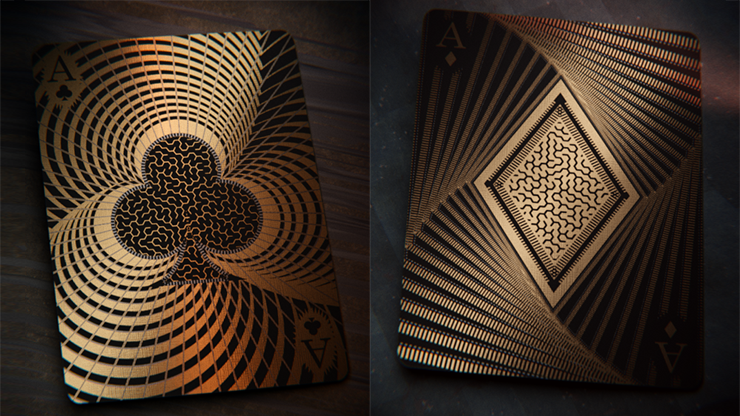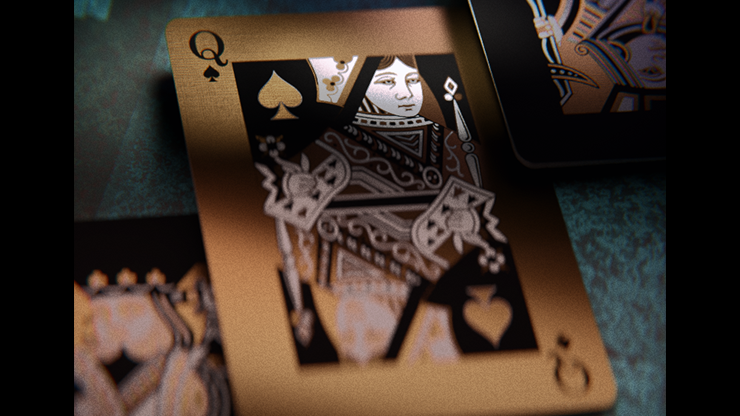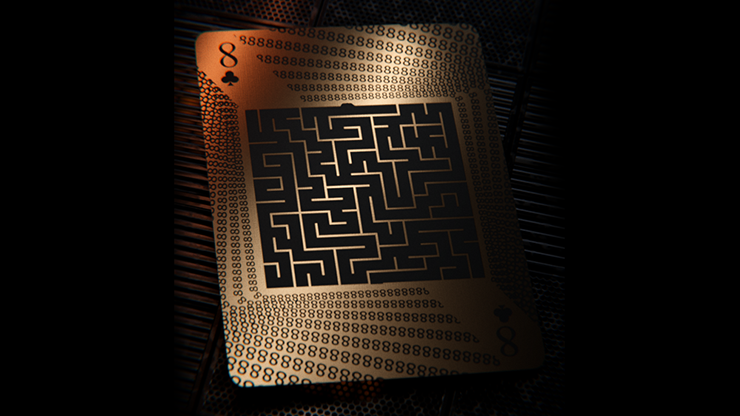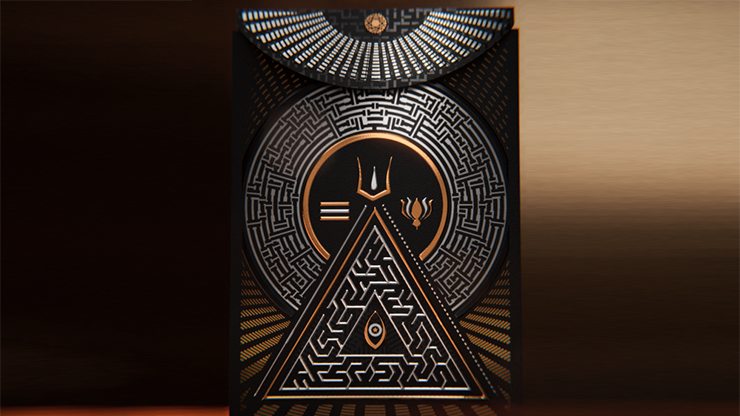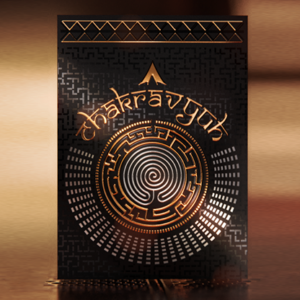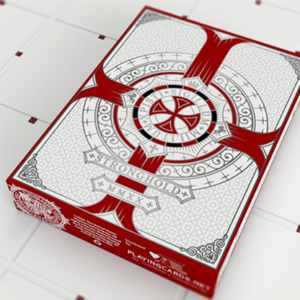Chakravyuh (The Maze) Playing Cards
£26.27
Features of the tuck case:
- Premium black high-gsm card stock with soft touch finish tuck case
- Reddish Gold, matte silver, and black foiled
- Embossed designs
- Produced by Legends Playing Cards Co.
Features of the playing cards:
- Premium Legends classic finished linen cardstock
- Special maze-based puzzle design
- Metallic ink printed cards.
In the great ancient Indian epic, the Mahabharata, two royal bloodlines, the Pandavas and the Kauravas fight against each other for the throne of Hastinapura, in the battle of Kurukshetra.
The Pandavas, led by the five righteous brothers, are formidable warriors, and with the divine lord Krishna by their side, they are poised to win the war. However, the Kauravas, are also masterful soldiers, and are proving a great challenge in the battle.
On the thirteenth day of the great fight, the Kauravas deployed the impenetrable formation, the Chakravyuh, to defend their flanks.
The Chakravyuh, a fluidic labyrinthine strategy, comprising of seven readjusting concentric spiral tiers of soldiers, designed to completely entrap its victim, was deployed to squash the Pandavas. Only a handful of warriors from the Pandava side knew how to penetrate the Chakravyuh, namely, Abhimanyu, Arjuna, Krishna and Pradyumna. However, on the day of the battle only Abhimanyu was present and he led the charge to penetrate this formation.
Abhimanyu, the son of Arjuna, received the knowledge of how to enter the formation whilst in his mother’s womb, as his maternal uncle, lord Krishna, was narrating the strategy to his pregnant sister Subhadra. However, Subhadra not finding the topic interesting fell asleep halfway, cutting the description of the strategy short. This small moment in his infancy would change the fate of Abhimanyu forever on the battlefield, as he was to face the armies of the Kauravas.
Trying to defend the Pandavas, Abhimanyu fought hard, and reached the sixth tier of the formation, and was attacked simultaneously by the mighty Kaurava commanders, an act against rules of righteous warfare. Here the small moment from his infancy would come back to haunt him, as he knew only how to enter the labyrinthine walls, not how to escape it. Facing an unwinnable battle, the Kauravas slowly exhausted Abhimanyu, with an incessant barrage of attacks, and finally killed the great warrior.
The Chakravyuh is a military strategic formation described in the Indian epic, the Mahabharata, deployed by the Kauravas to entrap the heroes of the tale, the Pandavas.
The brief story of the Chakravyuh in the epic, is included across the campaign page in segments, please read them to get a fuller understanding of the history that inspired this deck.
The triple foiled tuck box is inspired by the symbolism of the Mahabharata as well, as the vast canon of great Indian mythos and philosophy.
The playing cards themselves are themed around the concept of mazes, with each number card making up an individual and unique puzzle for you to enjoy for hours.
The Tuck Box
The design of the tuck box is inspired by the symbolism of the Mahabharata, as well as the vast canon of great Indian mythos and philosophy.
The central object of the tuck box, the Chakravyuh is foiled in matte silver. The seven tiers individually embossed create a wave like pattern against your fingers as you feel the details of the deck.
The outer shell, also a labyrinth, symbolizes the greater war that exists beyond the spiralling walls of the Chakravyuh. But there is an escape route, being directed by the large arrow, a compass on your way towards liberation.
The tuck box also has a running black foiled maze pattern, that enhances the look and detail of the deck. It makes the design continuous, though the six sides are unique.
The Back
The Back is based on the description of the universe as per the ancient scriptures of India.
There are 3 components to the design. The bottom pyramid, encompassing the spiritual eye
The central portion, on the top of the pyramid with 3 symbols making up the Hindu trinity, and finally the rays stretching out to the sides.
The three symbols that is central to the back design is Hindu trinity of Lord Brahma, the creator, symbolized by the lotus; the 3 horizontal lines signifying Lord Shiva, the destroyer; and the 3 vertical lines symbolizing Lord Vishnu the preserver, who holds the dynamic between creation and destruction of the cosmos.
They are central to the design as they are from which all the dynamics of the universe emanated and is being maintained.
The bottom half holds a pyramid which symbolizes the illusory world of Maya, with the spiritual eye in the middle. It is said through meditation you can see beyond this world and transcendent it to the planes beyond, primarily the astral and the causal.
After you escape the two-fold world of material and astral, there is the causal world which is signified by the large circular maze surrounding the 3 trinities at the centre.
When you go beyond the causal you reach the realm of liberation and you are no longer bound to suffering and this is signified by the rays at the edge of the design.
The top design is based on another maze design in the hexagonal pattern giving it a more unique look. The whole design is foiled and embossed giving it a more intriguing three-dimensional render.
The left side of the deck has a line from third chapter of the ancient Indian text, the Svetasvatara Upanishad, it says, “na anya pantha vidyate” or “The wise there is no other way.” Which means that There is no other means for the embodied being to attain supreme peace besides this. It also falls in line with the theme of the deck, the maze, which has only one way out.
The right side has our name embossed in gold foil, symmetrizing the design with the left-hand side.
The Cards
The Chakravyuh cards are not a standard deck of cards, with each number card possessing an unique maze puzzle at its centre.
Complimenting the tuck box, each card is printed with black and a reddish golden metallic ink, so it gives you that extra premium shine, not achieved using standard inks.
The cards also are finished in Legends Playing Cards Co. classic finish giving it immense playability with long durability for this precious deck.
The Card Back is a design made up of the 4 geometric shapes that form the 36 mazes of the four suits.
The square shape for the Clubs; the hexagon for the Spades; the Circle for the Hearts; and the triangle shape for the Diamonds.
The triangle also takes the shape of a compass arrow, as you are taking the deck out of the case.
The cards fan out to a beautiful golden deck, with the details forming a woodcut print pattern, breaking the flat golden print with contrasting detail.
The Four Suits:
The Clubs suit historically represented the peasantry, and achievements through hard work, hence the maze is made up of a simple shape, the square.
Each number card has its number making up the pattern of the design, so you can easily identify the denomination within each suit.
The Spades represented the warrior class, and the nobility; the class that dealt with the governance and maintenance of the world order, and hence, the hexagonal shape makes up the Spades suit, as it is the most complex shape having multiple sides to cover.
The Diamonds were for the merchant class, who were one directional and focused towards wealth creation, hence, a triangle describes their motivation the best, and makes up the central puzzles of the suit.
Finally, the Hearts, or the suit that represented the clergy – dedicating their life from a central point towards the grander revelation, a focus that needed to cover all angles.
The Face Cards:
Each face card is designed separately from the number cards, with a third white color in the negative space creating detail. It also delivers a contrast in the shininess between the metallic ink and the non-metallic areas leading to your eyes registering its richness even more.
The two standard colors of a standard deck of cards have been switched to a reddish-metallic ink and black, delivering the contrast envisioned in the original sets.
Each face card has added detail in the hair, the sword, the dress making it analogous with the main design theory of Chakravyuh playing cards deck.
The eye of each face card is painted black to give it depth, except for the King of Hearts, the suicide king, whose eyes have purposefully been left white, symbolizing death. A small easter egg in the pack.
The Aces:
The Aces are the crowning jewels of the deck, with each card creating an illusory 3D design from just 2 colors.
The four aces are in their alternating shades of black-bronze or bronze-black, and the depths generated by them are based on the prominence of the major shade.
The aces are the only cards which has their pips designed in a minimalist way so as to give the design the maximum breaking room.
The mazes inside each ace also have a solution but much harder to find, and due to the design of the cards they are not continuous, so a greater challenge for you if you wish to find it.
The Jokers:
The two Jokers of the deck are unique, they are 2 ornate doors signifying the beginning and end of your journey through the maze that is Chakravyuh.
One door, with the mood looming towards darker shades says “Knock twice to Enter,” a beginning of your perilous and long journey. The other is bright, welcoming, a final doorway towards escape; hence it says, “Knock twice to Exit.” However, for both doors someone, or some entity has to let you in or out, keeping in line with the Indian philosophy of the grace of a higher force driving the cosmos.
This is an extra order item and takes around 2-3 weeks to arrive).
41 In stock from our US warehouse (2-3 Weeks delivery)
Description
Description
Features of the tuck case:
- Premium black high-gsm card stock with soft touch finish tuck case
- Reddish Gold, matte silver, and black foiled
- Embossed designs
- Produced by Legends Playing Cards Co.
Features of the playing cards:
- Premium Legends classic finished linen cardstock
- Special maze-based puzzle design
- Metallic ink printed cards.
In the great ancient Indian epic, the Mahabharata, two royal bloodlines, the Pandavas and the Kauravas fight against each other for the throne of Hastinapura, in the battle of Kurukshetra.
The Pandavas, led by the five righteous brothers, are formidable warriors, and with the divine lord Krishna by their side, they are poised to win the war. However, the Kauravas, are also masterful soldiers, and are proving a great challenge in the battle.
On the thirteenth day of the great fight, the Kauravas deployed the impenetrable formation, the Chakravyuh, to defend their flanks.
The Chakravyuh, a fluidic labyrinthine strategy, comprising of seven readjusting concentric spiral tiers of soldiers, designed to completely entrap its victim, was deployed to squash the Pandavas. Only a handful of warriors from the Pandava side knew how to penetrate the Chakravyuh, namely, Abhimanyu, Arjuna, Krishna and Pradyumna. However, on the day of the battle only Abhimanyu was present and he led the charge to penetrate this formation.
Abhimanyu, the son of Arjuna, received the knowledge of how to enter the formation whilst in his mother’s womb, as his maternal uncle, lord Krishna, was narrating the strategy to his pregnant sister Subhadra. However, Subhadra not finding the topic interesting fell asleep halfway, cutting the description of the strategy short. This small moment in his infancy would change the fate of Abhimanyu forever on the battlefield, as he was to face the armies of the Kauravas.
Trying to defend the Pandavas, Abhimanyu fought hard, and reached the sixth tier of the formation, and was attacked simultaneously by the mighty Kaurava commanders, an act against rules of righteous warfare. Here the small moment from his infancy would come back to haunt him, as he knew only how to enter the labyrinthine walls, not how to escape it. Facing an unwinnable battle, the Kauravas slowly exhausted Abhimanyu, with an incessant barrage of attacks, and finally killed the great warrior.
The Chakravyuh is a military strategic formation described in the Indian epic, the Mahabharata, deployed by the Kauravas to entrap the heroes of the tale, the Pandavas.
The brief story of the Chakravyuh in the epic, is included across the campaign page in segments, please read them to get a fuller understanding of the history that inspired this deck.
The triple foiled tuck box is inspired by the symbolism of the Mahabharata as well, as the vast canon of great Indian mythos and philosophy.
The playing cards themselves are themed around the concept of mazes, with each number card making up an individual and unique puzzle for you to enjoy for hours.
The Tuck Box
The design of the tuck box is inspired by the symbolism of the Mahabharata, as well as the vast canon of great Indian mythos and philosophy.
The central object of the tuck box, the Chakravyuh is foiled in matte silver. The seven tiers individually embossed create a wave like pattern against your fingers as you feel the details of the deck.
The outer shell, also a labyrinth, symbolizes the greater war that exists beyond the spiralling walls of the Chakravyuh. But there is an escape route, being directed by the large arrow, a compass on your way towards liberation.
The tuck box also has a running black foiled maze pattern, that enhances the look and detail of the deck. It makes the design continuous, though the six sides are unique.
The Back
The Back is based on the description of the universe as per the ancient scriptures of India.
There are 3 components to the design. The bottom pyramid, encompassing the spiritual eye
The central portion, on the top of the pyramid with 3 symbols making up the Hindu trinity, and finally the rays stretching out to the sides.
The three symbols that is central to the back design is Hindu trinity of Lord Brahma, the creator, symbolized by the lotus; the 3 horizontal lines signifying Lord Shiva, the destroyer; and the 3 vertical lines symbolizing Lord Vishnu the preserver, who holds the dynamic between creation and destruction of the cosmos.
They are central to the design as they are from which all the dynamics of the universe emanated and is being maintained.
The bottom half holds a pyramid which symbolizes the illusory world of Maya, with the spiritual eye in the middle. It is said through meditation you can see beyond this world and transcendent it to the planes beyond, primarily the astral and the causal.
After you escape the two-fold world of material and astral, there is the causal world which is signified by the large circular maze surrounding the 3 trinities at the centre.
When you go beyond the causal you reach the realm of liberation and you are no longer bound to suffering and this is signified by the rays at the edge of the design.
The top design is based on another maze design in the hexagonal pattern giving it a more unique look. The whole design is foiled and embossed giving it a more intriguing three-dimensional render.
The left side of the deck has a line from third chapter of the ancient Indian text, the Svetasvatara Upanishad, it says, “na anya pantha vidyate” or “The wise there is no other way.” Which means that There is no other means for the embodied being to attain supreme peace besides this. It also falls in line with the theme of the deck, the maze, which has only one way out.
The right side has our name embossed in gold foil, symmetrizing the design with the left-hand side.
The Cards
The Chakravyuh cards are not a standard deck of cards, with each number card possessing an unique maze puzzle at its centre.
Complimenting the tuck box, each card is printed with black and a reddish golden metallic ink, so it gives you that extra premium shine, not achieved using standard inks.
The cards also are finished in Legends Playing Cards Co. classic finish giving it immense playability with long durability for this precious deck.
The Card Back is a design made up of the 4 geometric shapes that form the 36 mazes of the four suits.
The square shape for the Clubs; the hexagon for the Spades; the Circle for the Hearts; and the triangle shape for the Diamonds.
The triangle also takes the shape of a compass arrow, as you are taking the deck out of the case.
The cards fan out to a beautiful golden deck, with the details forming a woodcut print pattern, breaking the flat golden print with contrasting detail.
The Four Suits:
The Clubs suit historically represented the peasantry, and achievements through hard work, hence the maze is made up of a simple shape, the square.
Each number card has its number making up the pattern of the design, so you can easily identify the denomination within each suit.
The Spades represented the warrior class, and the nobility; the class that dealt with the governance and maintenance of the world order, and hence, the hexagonal shape makes up the Spades suit, as it is the most complex shape having multiple sides to cover.
The Diamonds were for the merchant class, who were one directional and focused towards wealth creation, hence, a triangle describes their motivation the best, and makes up the central puzzles of the suit.
Finally, the Hearts, or the suit that represented the clergy – dedicating their life from a central point towards the grander revelation, a focus that needed to cover all angles.
The Face Cards:
Each face card is designed separately from the number cards, with a third white color in the negative space creating detail. It also delivers a contrast in the shininess between the metallic ink and the non-metallic areas leading to your eyes registering its richness even more.
The two standard colors of a standard deck of cards have been switched to a reddish-metallic ink and black, delivering the contrast envisioned in the original sets.
Each face card has added detail in the hair, the sword, the dress making it analogous with the main design theory of Chakravyuh playing cards deck.
The eye of each face card is painted black to give it depth, except for the King of Hearts, the suicide king, whose eyes have purposefully been left white, symbolizing death. A small easter egg in the pack.
The Aces:
The Aces are the crowning jewels of the deck, with each card creating an illusory 3D design from just 2 colors.
The four aces are in their alternating shades of black-bronze or bronze-black, and the depths generated by them are based on the prominence of the major shade.
The aces are the only cards which has their pips designed in a minimalist way so as to give the design the maximum breaking room.
The mazes inside each ace also have a solution but much harder to find, and due to the design of the cards they are not continuous, so a greater challenge for you if you wish to find it.
The Jokers:
The two Jokers of the deck are unique, they are 2 ornate doors signifying the beginning and end of your journey through the maze that is Chakravyuh.
One door, with the mood looming towards darker shades says “Knock twice to Enter,” a beginning of your perilous and long journey. The other is bright, welcoming, a final doorway towards escape; hence it says, “Knock twice to Exit.” However, for both doors someone, or some entity has to let you in or out, keeping in line with the Indian philosophy of the grace of a higher force driving the cosmos.
This is an extra order item and takes around 2-3 weeks to arrive).
Additional Info
Additional information
| Weight | 0.09750566893424 kg |
|---|

